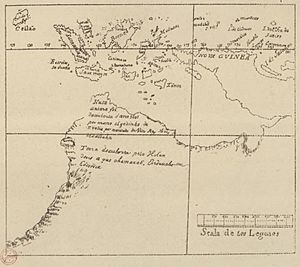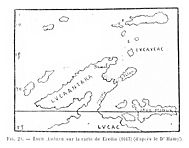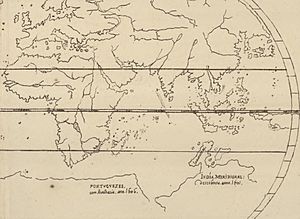Javanese contact with Australia facts for kids
The Javanese are people from the island of Java in Southeast Asia. For hundreds of years, people from Southeast Asia and Europe have talked about Javanese people being in Australia. One of the most famous stories comes from Chiaymasiouro, who was a king from Demak. Another important record is a book by Manuel Godinho de Eredia.
Chiaymasiouro wrote about a land called Luca Antara southeast of Java. Eredia later called this area India Meridional, which means "Southern India." Chiaymasiouro's stories from 1601 AD say that some Javanese people had already settled in these southern lands. However, when Eredia's helper visited Luca Antara in 1610, it seemed like no one was living there anymore.
Contents
History
Early Mentions (Before 1500)
People in Java talked about Australia and its native people as early as the 10th century AD. Old writings from the Mataram Kingdom (931 AD) and the Airlangga's era Kahuripan Kingdom (1000–1049 AD) in Java show that these kingdoms were very successful. They needed many workers to help with farming, packing goods, and sending them to ports.
Workers were brought in from places like Jenggi (which is Zanzibar), Pujut (Sarawak), and Bondan (Papua). Historians believe these workers either came to Java through trade (bought by merchants) or were captured during wars and became slaves.
European Maps (1500–1600)
A traveler named Ludovico di Varthema (1470–1517) wrote in his book that people from southern Java sailed to "far Southern lands." He said they reached an island where a day lasted only four hours and it was "colder than anywhere else." Today, experts think this island would have been very far south, even past the southern tip of Tasmania.
Around the early 1500s, some European maps started to show a large continent called Jave la Grande (or La Grande Jave). A mapmaker named Alfonse described La Grande Jave as a huge land connected to the Antarctic continent, or Terra Australis. He wrote that this "Java" reached the Strait of Magellan in the west and Terra Australis in the east.
Alfonse called the island of Java Jave Mynore (Minor Java). He named the big continent to the south La Grand Jave (Great Java). This was likely because Marco Polo had said that Java Major was the biggest island in the world.
Later Accounts (After 1600)
Luca Antara
Manuel Godinho de Eredia's book, Declaraçam de Malaca e India Meridional com o Cathay (1613), talked about "Meridional India" (Southern India). In his book, he shared the story of Chiaymasiouro, the king of Damuth (Demak) in Java. This king traveled to a southern land called Luca Antara.
- A map of Meridional India (Southern India); it looks a lot like Mercator’s map from 1569. The South is at the top of this map.
- The same map turned upside down, redrawn by Armand Rainaud (1893).
Eredia wrote that Meridional India included a mainland called Lucach, a peninsula named Beach, and a country called Lucaantara. East of Lucaantara were two small islands, Agania and Necuran, and a larger island called Java Minor. To the west were Angaman Minor (or Luca Tambini, the island of women) and Angaman Major (or Lucapiatto).
Old Javanese writings and records also mention Meridional India and its trade. In his 1610 report, Eredia said that in ancient times, merchants from Luca Antara traded a lot with Java. This trade stopped for 331 years because of wars. Communication between the two places didn't start again until the year 1600.
In 1600, a boat from Lucaantara was blown off course by a storm. It landed in the port of Balambuam (Blambangan) in Java. The people on the boat were welcomed there.
The visitors from Lucaantara looked like the Javanese of Banten, but they spoke a different language. This made Eredia think they were a different kind of Javanese. This event made King Chiaymasiouro curious. He decided to sail south from Blambangan in a kelulus (a type of boat with oars and sails).
After 12 days, he arrived at the port of Lucaantara. This land was either a peninsula or an island, about 600 Spanish leagues (around 3,300 km) around. The syahbandar (a port official) welcomed him, as the king of Lucaantara lived far inland. Chiaymasiouro stayed there for several days.
Chiaymasiouro wrote a letter to the King of Pahang about his journey:
I got ready for my trip and took what I needed. I sailed with some friends in a kelulus (a boat with oars) from Blambangan, heading south. After 12 days, I reached the port of Lucaantara. I got off the boat and the syahbandar welcomed me warmly. I was tired from the trip, so I couldn't meet the King of Lucaantara, who was eight days away upriver.
The King heard I had arrived and sent me some gold coins that looked like the gold coins from Venice. I was treated very well while I stayed there. The weather was wonderfully cool and fresh. I saw a lot of gold, cloves, mace, white sandalwood, and other spices. There was also a lot of food of all kinds grown in this country.
The island of Lucaantara is as big as Java, where Blambangan is. The people are Javanese, just like in our Java, but their language is a bit different. They wear their hair down to their shoulders, and they have a band of hammered gold around their heads. Their keris (a type of dagger) is decorated with jewels, like the curved keris in Bali.
Generally, the Javanese people of Lucaantara spend all their time playing sports and having fun. They especially love cock-fighting. When it was time to leave, I asked the syahbandar to tell the King that the winds were good for my return. I got supplies and left Lucaantara. After a few days, I arrived back at Blambangan. Everyone in Java was very surprised.
— From a letter by Chiaymasiouro, king of Damuth, to the king of Pahang
Soon after Chiaymasiouro returned in 1601, he met Pedro de Carvalhaes, an official from Malacca. Pedro confirmed Chiaymasiouro's story about his trip. Pedro wrote that he met Chiaymasiouro in Surabaya. Chiaymasiouro told him how a boat from Lucaantara was pushed off course by a storm and landed in Blambangan.
Pedro de Carvalhaes's statement:
I, Pedro de Carvalhaes, a citizen and official of Malacca, confirm that I met Chiaymasiouro, King of Damuth, in Surabaya. During our talk, he told me how "a rowing-boat from Lucaantara, driven off course by currents and bad weather, reached the port of Blambangan." I was curious, so I ordered a calelus (boat with oars) to be prepared with all needed supplies. I set out with some friends from Blambangan, heading south. After a 12-day trip, I reached the port of Lucaantara. The people there welcomed and entertained me well. They are Javanese, like those from Java Major (the real Java). They look similar and have similar interests, though their language is different. The island of Lucaantara is more than 600 leagues around. I saw a lot of gold, cloves, mace, white sandalwood, and other spices. There was also a lot of food of every kind grown in this country. The land is very fertile, and the trees keep the climate cool. The country has many kingdoms and lots of busy towns and villages. All of this was told to me by Chiaymasiouro and his friends. This story about Lucaantara was well-known in Surabaya and other parts of Java Major. Manuel Godinho de Eredia asked me for this information for his journey and for the King’s service. I swear by the Holy Gospels that this is true, and my signature is below. At Malacca, on October 4, 1601. — Pedro de Carvalhaes
After hearing this story, Eredia sent one of his own helpers to Java. This helper joined some fishermen on the southern coast of Java. They sailed for 6 days to the coast of Luca Antara. He landed on an empty coast and saw no people. The helper stayed there for 3 days. He confirmed that Chiaymasiouro's story about the gold, metals, minerals, jewels, cloves, nutmegs, mace, and sandalwood was true. After 3 days, he returned to Java and reported his journey in 1610.
In his 1610 report, Eredia also said that the Javanese people of Luca Antara looked and acted like the Javanese of Sunda (West Java). He noted only a small difference in their language, like the difference between Spanish and Portuguese. Their hair reached their shoulders, and their hairstyles were similar to those of Balinese people.
Disagreements About Luca Antara
Some people, like Richard Henry Major (in 1873), disagreed that Lucaantara was Australia. However, J. V. Mills (in 1930) responded to these objections. Here are some of the main points of their debate:
| Point | Major's Argument | Mills's Response |
|---|---|---|
| 1 | The 600-mile (966 km) journey from Java to Australia is too far to do in 12 days. | Major thought the boat only used oars. But Eredia said the boat had both sails and oars. A speed of 50 miles (80.5 km) a day for a fast boat is actually quite normal. For example, a thousand years before this, a monk named I-tsing sailed 1700 miles (2736 km) from Canton to Palembang in 20 days (about 85 miles or 136.8 km a day). Also, the trepanger boats from Makassar to Marege (in Arnhem Land) traveled about 1600 km (994 miles) in 10–15 days, which is 107–160 km (66.3–99.4 miles) a day. |
| 2 | The island of Madura matches Eredia’s description of Luca antara. | There are several reasons why this is unlikely. (1) To get to Madura from southeast Java, Chiaymasiouro would have to sail against the usual wind patterns, which is hard. (2) Chiaymasiouro, being a prince from Demak, would surely be recognized in Madura. It's unlikely he would pretend to discover a place where he was already known. (3) Pedro de Carvalhaes said the story was well-known in Surabaya. People in Surabaya would know if it was a trick, because Madura is only a mile away from Surabaya. Also, Luca antara was said to be as big as Java, but Madura is only about 1/30th the size of Java. |
| 3 | Major couldn't find the name Damuth on any old or new maps of Java, suggesting Eredia made up the name. | Mills believed that Damuth was definitely Demak. He pointed out that Demak (also spelled Damak) is an ancient town northeast of Semarang in Java. A 1615 map by Lavanha even calls that area "Damo." |
| 4 | The letter from Chiaymasiouro to the King of Pahang seems pointless and fake. | Mills argued that just because we don't know why a letter was written doesn't mean it wasn't real. He also said there's nothing unusual about communication between East Java and the Malay Peninsula. The Malay Annals (1612) mention that a prince from Surabaya visited Malacca. A traveler named Manrique (1640) also said people were constantly traveling between Demak and Malaya. |
| 5 | Luca antara is drawn with very detailed coastlines, rocks, and shallow areas. | Mills said that these details shouldn't be taken too seriously. Many old maps included imaginary monsters and other details that weren't real. |
| 6 | What we know about Australia doesn't match Eredia's description of Luca antara. | Mills said that Eredia wasn't the one describing Luca antara. The description came from Chiaymasiouro and Eredia's servant. So, if the description doesn't match Australia, it's their responsibility, not Eredia's. |







